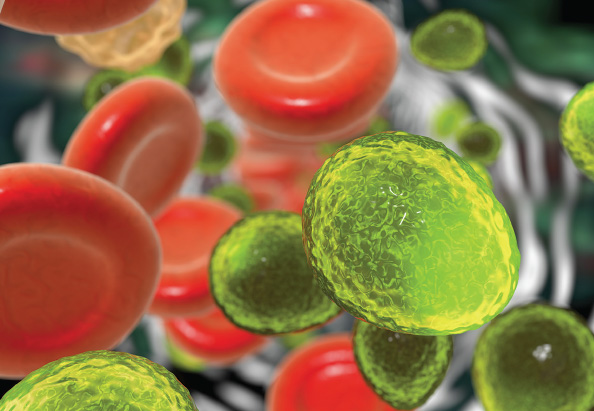Research updates in COVID-19, pediatric dermatology, infectious diseases, atopic dermatitis, cutaneous oncology, and more
By Ted Rosen, MD, FAAD, Editor-in-Chief
Off-label pearl
Pentoxifylline for treatment of claudication
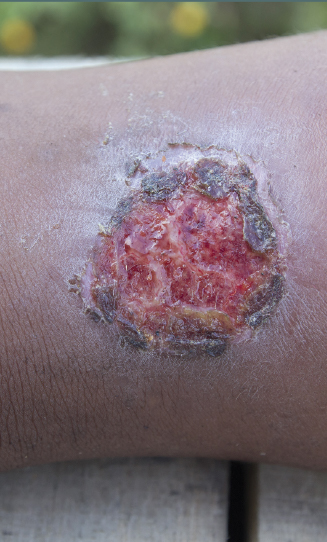
Pentoxifylline is an oral xanthine derivative FDA-approved for the treatment of claudication. Pentoxifylline increases deformability of red blood cells, decreasing blood viscosity and enhancing tissue oxygenation. As a phosphodiesterase inhibitor, it inhibits platelet microvascular adhesion and aggregation, and exerts vasodilation. In aggregate, these properties allow pentoxifylline to help resolve stubborn venous stasis ulcers, with or even without compression. Dose is 400 mg TID. Side effects are mild and uncommon, including GI distress, headache, and dizziness. This is an old but seemingly forgotten paper: Jull AB, Arroll B, Parag V, Waters J. Pentoxifylline for treating venous leg ulcers. Cochrane Database Syst Rev. 2012 Dec 12;12:CD001733. https://pubmed.ncbi.nlm.nih.gov/23235582
Rosacea
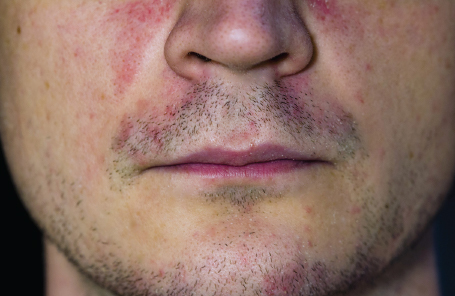
An investigator-blinded prospective study (N=97) demonstrated that once-daily sarecycline (1.5 mg/kg) was statistically superior to a multivitamin placebo for the treatment of moderate-to-severe papulopustular rosacea. Sarecycline was tolerated by subjects during this 12-week study. TO READ MORE: Rosso J, et al. Oral sarecycline for treatment of papulopustular rosacea: results of a pilot study evaluation of effectiveness and safety. J Drugs Dermatol. 2021; 20(4):426-431. https://pubmed.ncbi.nlm.nih.gov/33852248 (Editor’s note: Although a larger scale study is advisable, this pilot investigation was very promising.)
Pediatric dermatology
Candida blood stream infections, often associated with disseminated cutaneous papules, are seen among immunocompromised children and in the neonatal intensive care unit. This year, a retrospective study done in New England demonstrated that anti-fungal drug resistance was minimal: 96.7% of isolates were fluconazole, 99% were micafungin, and all were amphotericin susceptible. TO READ MORE: Piqueras A, et al. Trends in pediatric candidemia: epidemiology, anti-fungal susceptibility, and patient characteristics in a children’s hospital. J. Fungi. 2021;7(2):78; doi:10.3390/jof7020078
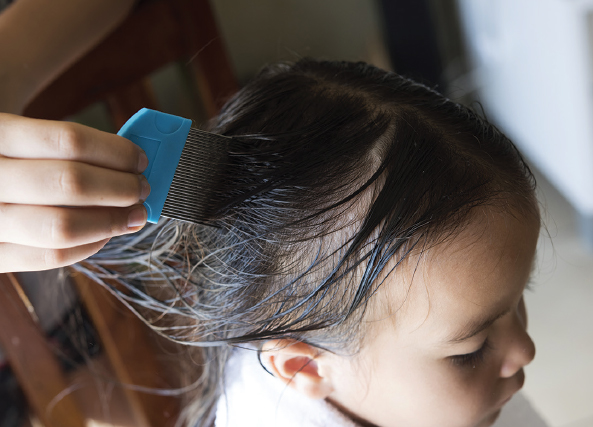
A “no-nit” policy, still common in parts of the US and Canada, is “without medical or public health merit” and that expulsion of children from camp, daycare, or school based solely on the presence of nits after treatment “may harm the child’s self-esteem and impose unnecessary burdens on the parents.” TO READ MORE: Mumcuoglu KY, et al. International recommendations for an effective control of head louse infestations. Int J Dermatol. 2021;60:272-80. https://doi.org/10.1111/ijd.15096
In a one-year, open-label, multi-center prospective study (N=62, age 6-16), daily topical efinaconazole 10% solution for 48 weeks led to 40% complete clinical cure and 65% mycologic cure. Topical efinaconazole 10% appears to be a good option for mild-to-severe onychomycosis in the pediatric population. TO READ MORE: Eichenfield LE, et al. Efinaconazole 10% topical solution for the treatment of onychomycosis in pediatric patients: Open-label phase 4 study. J Am Acad Dermatol. 2021;84(4):1140-1142. https://pubmed.ncbi.nlm.nih.gov/32622145/
Infectious diseases
As part of the never-ending search for the “best” intralesional immunotherapy for verrucae, a cohort of 150 periungual wart patients was randomized to treatment every 2 weeks for a maximum of 5 sessions with 0.1 ml of either Candida antigen, MMR, or PPD. All agents performed well: wart clearance occurred in 80% of the Candida antigen group, 74% of the MMR group, and 70% of the PPD group. Most importantly, the authors also demonstrated distant response of untreated warts. Local side effects were acceptable, and a flu-like syndrome occurred in 10% of those treated with Candida, 4% with MMR, and 6% with PPD. After 6 months of follow-up, patients who had cleared did not have recurrences. TO READ MORE: Nofal A, et al. Intralesional antigen immunotherapy in the treatment of periungual warts. J Cutan Med Surg. 2021;Jan 27: doi:10.1177/1203475420988859
Continuing once-daily application of efinaconazole 10% solution to nails affected by onychomycosis longer than the currently recommended 12 months leads to continued increase in mycological cure and effective therapy (<10% involvement of the target toenail). No new safety issues appeared during the planned 24 months of continuous treatment. TO READ MORE: Gupta AK, Cooper Ea. Long-term efficacy and safety of oncedaily efinaconazole 10% topical solution (Jublia) for dermatophyte onychomycosis: an interim analysis. Skin Ther Lett. 2021;26(1):5-10. https://pubmed.ncbi.nlm.nih.gov/33539062
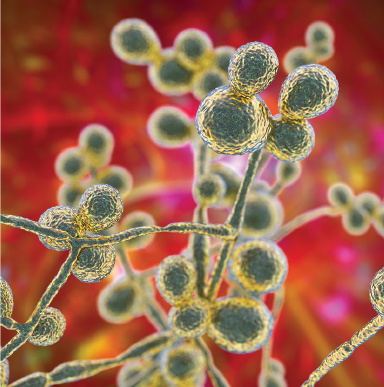
The antifungal agent T-2307 appears to be particularly useful for Candida species (including C. auris ) and the 2 major species of Cryptococcus. The agent works via a novel mechanism of action, namely by interfering with mitochondrial membrane potential, thereby inhibiting proper mitochondrial function. TO READ MORE: Wiederhold NP. Review of T-2307, an investigational agent that causes collapse of fungal mitochondrial membrane potential. J. Fungi. 2021:7(2),130; doi:10.3390/jof7020130
2404 men enrolled in a 3-year study comparing incident STD before and after initiation of preexposure prophylaxis (PreP). Although the frequency
of STD testing rose following the onset of PreP, there was no significant increase in STD test positivity rates. TO READ MORE: McManus H, et al. Comparison of trends in rates of sexually transmitted infections before vs after initiation of HIV pre-exposure prophylaxis among men who have sex with men. JAMA Netw Open. 2020;3(12):e2030806. doi:10.1001/jamanetworkopen.2020.30806 (Editor’s note: In other words, initiating PreP in demographic groups at risk for HIV acquisition doesn’t lead to more STD.)
Contact dermatitis
A large cohort of patients with eyelid dermatitis, from sites all across the United States, were analyzed. Irritant contact dermatitis was more common if only eyelids were involved, whereas allergic contact dermatitis was more frequent if head and neck sites were also involved. An atopic diathesis was common among those with any type of eyelid dermatitis. TO READ MORE: Warshaw E, et al. Eyelid dermatitis in patients referred for patch testing: retrospective analysis of North American Contact Dermatitis Group data, 1994-2016. J Am Acad Dermatol. 2021;84(4):953-964. doi: 10.1016/j.jaad.2020.07.020
Hidradenitis suppurativa
While adalimumab can offer significant improvement in disease burden for HS patients, British investigators found that nearly 32% of patients experienced drug-related adverse events, including worsening mental health status. TO READ MORE: Muralidharan V, et al. Real life data on the biopsychosocial effects of adalimumab in the management of hidradenitis suppurativa: A multicenter cross sectional analysis and consideration of a multisystem monitoring approach to follow up. Dermatol Ther. 2021 Jan;34(1):e14643. doi: 10.1111/dth.14643.
A retrospective chart review, enhanced by telephone interviews, assessed the benefit of intralesional injections of high concentration (20 or 40 mg/ml) triamcinolone acetonide during active outbreaks of HS. Patients noticed increased mobility (59%), better sleep (50%), and decreased drainage (69%). 86.3% of the 54 respondents would be willing to undergo future injections. TO READ MORE: Garelik J, et al. Efficacy of high-dose intralesional triamcinolone for hidradenitis supprativa. Int J Dermatol. 2021;60:217-21 doi: 10.1111/ijd.15124
The authors performed a systematic literature review and meta-analysis related to the occurrence of major cardiovascular events associated with HS. Using high-quality cohort and case-control studies, they found an increased risk of both heart attack and stroke in HS patients. The clinician should be screening for such events, looking for early warning signs. TO READ MORE: Bailey AMJ, et al. Hidradenitis and major adverse cardiac events: A systematic review and meta-analysis. J Am Aced Dermatol. 2021;84:844-846. doi: 10.1016/j.jaad.2020.10.005
Cutaneous oncology, surgery, and lasers
A joint group of Dutch and Australian investigators, using large cohorts, developed and validated nomograms to predict which patients with thin melanomas were at risk for local, regional, and distant recurrences. This was then translated into a simple, free online tool: www.melanomarisk.org.au. TO READ MORE ABOUT THIS POWERFUL INSTRUMENT: El-Sharouni MA, et al. Development and validation of nomograms to predict local, regional, and distant recurrence in patients with thin (T1) melanomas. J Clin Oncol. 2021; Feb 18. doi:10.1200/JCO.20.02446 (Editor’s note: try the online tool; it is easy to use and quite informative.)
A single-center, retrospective analysis was conducted to assess the complication rate when Mohs micrographic surgery was conducted on those over age 85. Infection, wound dehiscence, hematoma formation, post-operative hemorrhage, flap necrosis, and graft necrosis were noted in small numbers of cases among the 949 patients (1683 lesions) studied. The overall complication rate was a remarkably low 1.78%, even in this very aged patient subset. TO READ MORE: Nemer KM, et al. Complications after Mohs micrographic surgery in patients aged 85 and older. Dermatol Surg. 2021;47(2): 189-193. doi: 10.1097/DSS.0000000000002452
Although surgical excision remains the standard of care for lentigo maligna, topical application of 5% imiquimod (5 times weekly for 12 weeks) may also be effective. Analysis of a cohort of 103 patients followed for a median 5.1 years (mean 6.2 years) demonstrated 89% disease- and recurrence-free survival. TO READ MORE: Chambers M, et al. Topical imiquimod for lentigo maligna: Survival analysis of 103 cases with 17 years follow-up. J Drugs Dermatol. 2021;20(3):346-48. doi: 10.36849/JDD.5660
A single-center retrospective review covering a recent 7-year period disclosed that 73% of mycosis fungoides patients who received topical corticosteroid monotherapy responded, with a 65% decrease in affected body surface area. Early-stage disease and female gender were more represented in the responder group. TO READ MORE: Kartan S, et al. Response to topical corticosteroid monotherapy in mycosis fungoides. J Am Acad Dermatol. 2021;84:615-25. doi: 10.1016/j.jaad.2020.05.043
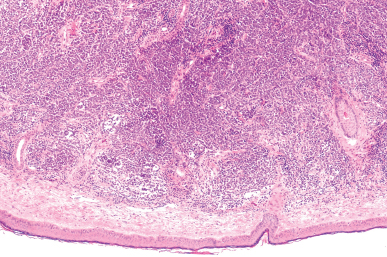
In a large (N=6156) cohort study, local excision of merkel cell carcinoma with margins over 1 cm was associated with higher overall survival compared to smaller excisional margins. Addition of adjuvant radiotherapy to larger excisional margins increased overall survival even more. TO READ MORE: Andruska N, et al. Association between surgical margins larger than 1 cm and overall survival in patients with merkel cell carcinoma. JAMA Dermatol. 2021, March 24. doi:10.1001/jamadermatol.2021.0247
General dermatology
While clinical benefit from a gluten-free diet is most closely associated with dermatitis herpetiformis, several other diseases may also improve. Most notably, there is significant evidence that chronic, recurrent aphthous stomatitis; alopecia areata; palmoplantar pustulosis; and even psoriasis may benefit from elimination of gluten from the diet. TO REVIEW THE EVIDENCE, READ: Muddasani S, et al. Gluten and skin disease beyond dermatitis herpetiformis: a review. Int J Dermatol. 2021;60:281-88. https://doi.org/10.1111/ijd.15098
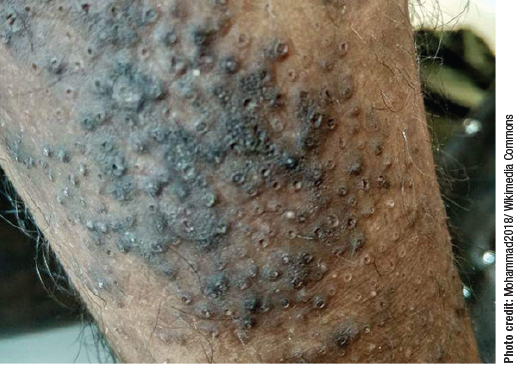
Lichen amyloidosis may respond to topical application of fixed combination halobetasol-tazarotene lotion. Clinical benefit is likely due to synergistic anti-inflammatory effects and the retinoid’s capacity to reduce hyperkeratosis and epidermal acanthosis. TO READ MORE: Shoen E, et al. Successful treatment of lichen amyloidosis using a fixed combination of halobetasol propionate and tazarotene lotion. J Drugs Dermatol. 2021;20:336-37. doi: 10.36849/JDD.5794
COVID-19
Some patients may develop ipsilateral axillary adenopathy on average 2-4 days after receipt of either mRNA COVID-19 vaccine. This may resemble a pattern strongly suggestive of breast cancer. Adenopathy typically resolves in about 10 days. TO READ MORE: Mehta N, et al. Unilateral axillary adenopathy in the setting of COVID-19 vaccine. Breast Imaging. 2021;75:12-15. https://pubmed.ncbi.nlm.nih.gov/33486146 (Editor’s note: For those who want to “catch up” on the various cutaneous signs of COVID-19 infection, we recommend this mercifully concise summary: Schwartzberg L, et al. Cutaneous manifestations of COVID-19. Cutis. 2021;107:90-94.) https://pubmed.ncbi.nlm.nih.gov/33891838
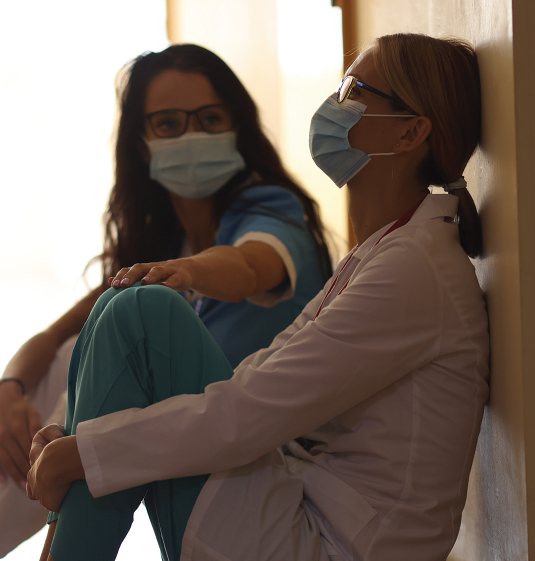
A Kaiser Family Foundation/Washington Post nationally representative survey of more than 1300 health care workers found that nearly two-thirds of those interviewed report worry or stress related to COVID. Many feel “burned out” at work and about half have experienced abnormal sleep patterns. TO READ MORE: Kirzinger A, et al. KFF/The Washington Post Frontline Health Care Workers Survey. Published online and accessible at: https://www.kff.org/coronavirus-covid-19/pollfinding/kff-washington-post-health-care-workers
Using complex models, CDC investigators concluded that 59% of COVID transmission comes from asymptomatic individuals. This includes 35% from those who eventually will develop symptomatic disease and 24% from those who never will develop symptomatic disease. TO READ MORE: Johansson MA, et al. SARS-CoV-2 transmission from people without COVID-19 symptoms. JAMA Netw Open. 2021 Jan 4;4(1):e2035057. doi: 10.1001/jamanetworkopen.2020.35057
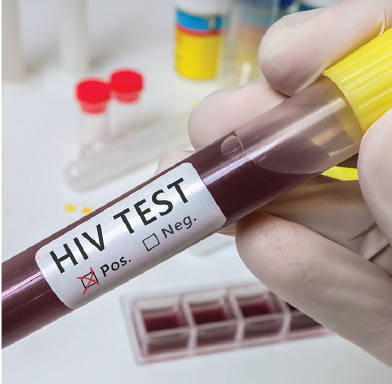
A retrospective study done in New York state revealed that the rate of COVID diagnosis among the general population was 19.4 per 1000 persons, lower than the rate among those living with HIV, which was 27.7 per 1000 persons. Hospitalization rate due to COVID was about 2 times greater and mortality rate about 3 times higher among the HIV co-infected compared to the general population. TO READ MORE: Tesoriero JM, et al. COVID-19 outcomes among persons living with or without diagnosed HIV infection in New York State. JAMA Netw Open. 2021;4(2):e2037069. doi:10.1001/jamanetworkopen.2020.37069
Cosmetic dermatology
To effectively manage periorbital hyperpigmentation, it is imperative to determine the etiology: volume loss or melanin or vascular anomaly. Appropriate treatments which follow from this determination might include: soft tissue filers and autologous fat transplantation; chemical peels, hydroquinone or vitamin serums; carboxytherapy and platelet rich plasma injections; or laser surgery. TO READ MORE: Michelle L, et al. Treatments for periorbital hyperpigmentation: a systematic review. Dematol Surg. 2021;47(1):70-74.
Rheumatologic diseases
Literature suggests that ingestion of herbal supplements designed to be immnostimulatory may lead to acute onset, flare, or both of autoimmune cutaneous disorders (such as lupus). These include several forms of microalgae, echinacea, and alfalfa. It is therefore reasonable and rational to screen patients with autoimmune skin diseases for herbal supplement use. TO READ MORE: Bax CE, et al. The effects of immunostimulatory herbal supplements on autoimmune skin diseases. J Am Acad Dermatol. 2021;84(4):1051-58. doi: 10.1016/j.jaad.2020.06.037
Atopic dermatitis/eczema
A small Japanese cohort of moderate-to-severe atopics was treated with dupilumab. Not only did clinical parameters (EASI, IGA, BSA) improve, but also serum IgE and peripheral eosinophil counts improved from pre-treatment, elevated state. TO READ MORE: Yamauchi T, et al. Dupilumab treatment ameliorates clinical and hematological symptoms, including blood eosinophilia, in patients with atopic dermatitis. Int J Dermatol. 2021;60:190-95. https://doi.org/10.1111/ijd.15183
Investigators from India found that patients with hand eczema, regardless of basic cause, were under very high stress (16.1%) and high stress (51.6%). It was not clear if the stress contributed to the hand eczema or resulted from the hand eczema.
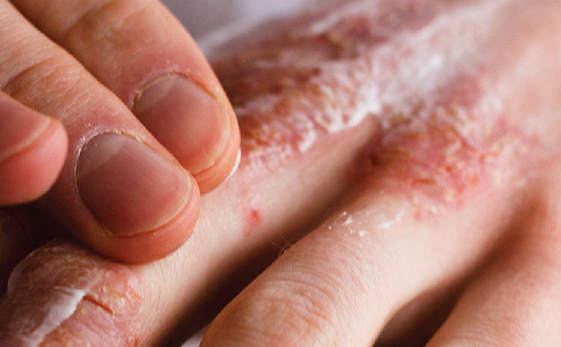
In any event, stress management might be considered in patients with hand dermatitis. TO READ MORE: Janardhanan AK, et al. Therapeutic considerations related to stress levels associated with hand eczema: A clinic-etiological study. Dermatol Ther. 2020 Nov;33(6):e14508. doi: 10.1111/dth.14508
Based upon reports received by the FDA, the most common adverse event associated with dupilumab are ocular. These include (in order of decreasing frequency): conjunctivitis, eye pruritus, ocular hyperemia, dry eye, eye “irritation,” and increased lacrimation. All adverse events occurred in less than 5% of patients. TO READ MORE: Wang Y, Jorizzo J. Retrospective analysis of adverse events with dupilumab reported to the United States Food and Drug Administration. J Am Acad Dermatol. 2021;84(4):1010-1014. doi: 10.1016/j.jaad.2020.11.042
Acne
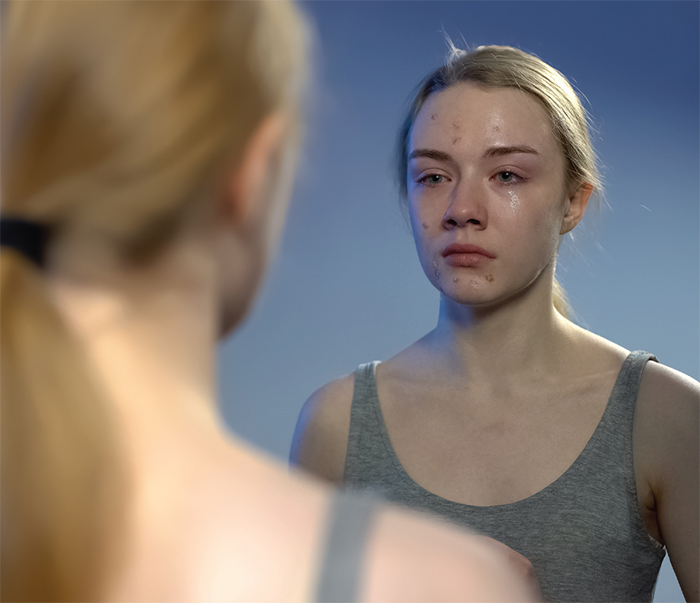
The impact of acne on quality of life is important to remember. Acne has been clearly associated with increased risk of stress (with associated excoriation disorder); social phobia disorder; fear and anxiety; depression and suicidal thoughts/attempts; sexual dysfunction; and stigmatization. Mental health intervention may well be required. TO READ MORE: Stamu-O’Brien C, et al. Psychodermatology of acne: psychological aspects and effects of acne vulgaris. J Cosmet Dermatol. 2021;20(4):1080-1083. doi: 10.1111/jocd.13765
A small case series (N=6) verified the benefit of treating the acneiform eruption associated with select chemotherapeutic agents with either acitretin or isotretinoin, although the latter appeared to be more effective.
TO READ MORE: Costello CM. Choosing between isotretinoin and acitretin for epidermal growth factor receptor inhibitor and small molecule tyrosine kinase inhibitor acneiform eruption. J Am Acad Dermatol. 2021;84:840-41. doi: 10.1016/j.jaad.2020.09.090
Drugs and devices
A recurrent epidermal cyst was punctured by ultrasound-guided large-bore needle; the cyst was then subjected to repeated injections of a sclerosing agent (1 ml of anhydrous alcohol), followed by aspirations, until the withdrawn fluid was clear. Pressure was applied. The cyst resolved without any sequela. TO READ MORE: Zhang Q, Huang Y. Ultrasoundguided sclerotherapy for recurrent epidermoid cyst: A case report. Dermatol Therapy. 2021 Jan;34(1):e14552. doi:10.1111/dth.14552
A systematic review and meta-analysis of 11 studies (including more than 410,000 treated patients) revealed an association between topical calcineurin use and risk of lymphoma but not any other type of cancer. However, the absolute risk of lymphoma was quite small, making the risk to any individual patient very low. TO READ MORE: Lam M, et al. Association between topical calcineurin inhibitor use and risk of cancer, including lymphoma, keratinocyte carcinoma, and melanoma. A systematic review and meta-analysis. JAMA Dermatol. 2021, March 31. doi:10.1001/jamadermatol.2021.0345
Hair and nails
Bitemporal hair loss carries a broad differential diagnosis, including both scarring and non-scarring etiologies. The results of a hair pull test, the presence (or absence) of a “fringe sign,” symptomatic pruritus, and family history can help determine the precise diagnosis. TO READ MORE: De Souza B, et al. Bi-temporal scalp hair loss: differential diagnosis of nonscarring and scarring conditions. J Clin Aesthet Dermatol. 2021;14(2):26-33. https://jcadonline.com/hair-loss-differential-diagnosis-scarring
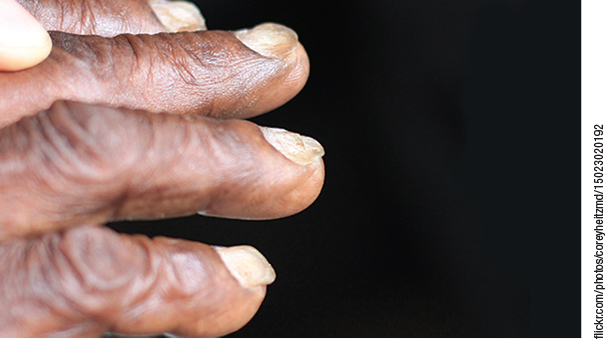
Koilonychia, or “spoon-shaped” nails, is most typically associated with iron deficiency. This case reminds us that this specific nail finding can rarely also be seen in conjunction with alopecia areata. Oral corticosteroids, given for the hair loss, also led to resolution of nail findings. TO READ MORE: Litaiem N, et al. Koilonychia in a patient with alopecia areata. J Clin Aesthet Dermatol. 2021;14(2):42-43. https://jcadonline.com/koilonychia-alopecia-areata (Editor’s note: pitting and trachonychia are the common nail findings in alopecia areata.)

